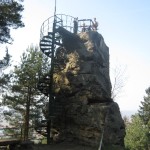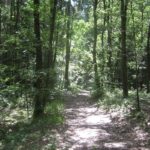
Last Friday, I drove over the border into Germany, in order to visit the Bastei, a major landmark in the Sächsische Schweiz/Saxon Switzerland. The Bastei is a rock formation consisting of a series of eroded sandstone pillars, towering above the Elbe river.
Rather than drive to the nearest car park and almost certainly pay a substantial parking fee, instead I drove to the village of Rathewalde. However, even parking there cost me €2.00!
Walking down the main street of Rathewalde, I joined the yellow waymarked route which headed gently upwards into the forest and the National Park.
After walking for about forty minutes, I reached a viewpoint from which the following two photographs were taken.


Then it was onto Bastei itself from where there are spectacular views of the Elbe river below.

This is the view looking east, with the hills in the far distance, forming the boundary with the Czech Republic. Below, on the right side of the river is Oberrathen, where there is a station on the Decín-Dresden railway line. On the left side of the river is Niederrathen – the two being connected by a passenger ferry.

The view westwards shows the Elbe as it heads towards Dresden with the village of Stadt Wehlen in the distance on the right.

Several of the sandstone pillars are connected by the Bastei bridge, completed in 1851 and replacing an earlier wooden structure. My apologies for a bit of sun-glare in the photograph. At the far end of the bridge are the remains of Neurathen Castle.
Rather than retrace my steps, I decided to return to Rathewalde by the blue waymarked route. This descended steeply and far further than I was expecting 😉 into a deep valley. The path mainly consisted of a series of steps which I was very glad to have chosen to descend, rather than ascend!

At the valley bottom, the path turned left and headed uphill to this waterfall – Amselfall, adjacent to which was a very welcome cafe with outdoor tables and seating. Here I enjoyed lunch, accompanied by a large beer, which provided the sustenance I needed for the climb up the valley, back into Rathewalde.

A sign outside the village Lutheran Church was most welcoming. So I very much enjoyed exploring the Church, still beautifully decorated for Easter, taking time to quietly pray, before returning to the ‘Carly’ and driving back home, over the border.





How cool that this beautiful area is essentially in your backyard! I’ve been wanting to visit for a few years now – thinking it would be fun to camp over the border in Germany and then visit one of these days.
This beautiful area is effectively my backyard. It is a major reason why I chose to live here. Now the weather has improved significantly, I intend to get out & explore it some more – blog posts will follow! Do come and visit – there are a variety of accommodation possibilities from campsites to pensions/small hotels & plenty of signs saying ‘Zimmer frei‘ 🙂
Hi Ricky,
As always I’m impressed with your photographic skills, your photographs convey much more than the fabled ‘1000 words’, thank you yet again for such great illustrations. Those sandstone pillars are truly ‘awesome’ to borrow an over used term from youth culture. The forces involved and the timescale required in their creation boggle the mind and point up the insignificance of humanity’s efforts to construct wonders. The river Elbe flowing there in a gorge through uplands showing the power of water over time to wear down even solid rock and remove it to the oceans – surely this contains a lesson for our powerful elites ‘this too will pass away in time’. We can learn so much from the power of natural processes if we just learn to open our minds.
Nice to see that church open for random visitors to call in and pray or just sit in peace; sadly in Ireland it has become common for roving gangs of thieves and vandals to attack and desecrate churches, especially in rural areas. Thanks again Ricky.
Hi Sean,
Thank you yet again, for your kind compliments about my photographs. Certainly at Bastei, it is much simpler and better to let the pictures do the talking. I concur with all you say about the amazing forces of nature that created this landscape in comparison with ‘humanity’s efforts to construct wonders’.
I was very pleasantly surprised to find the Church open and clearly advertised as such. What you describe as happening in Ireland is sadly what happened in the Czech Republic, in the first years following the fall of communism. There was wide scale theft of valuable items from open Churches which has led to most of them now being kept locked, except when in use for worship. Rathewalde is located in the former communist East Germany where presumably the post-communist experience in relation to Church property has been better.